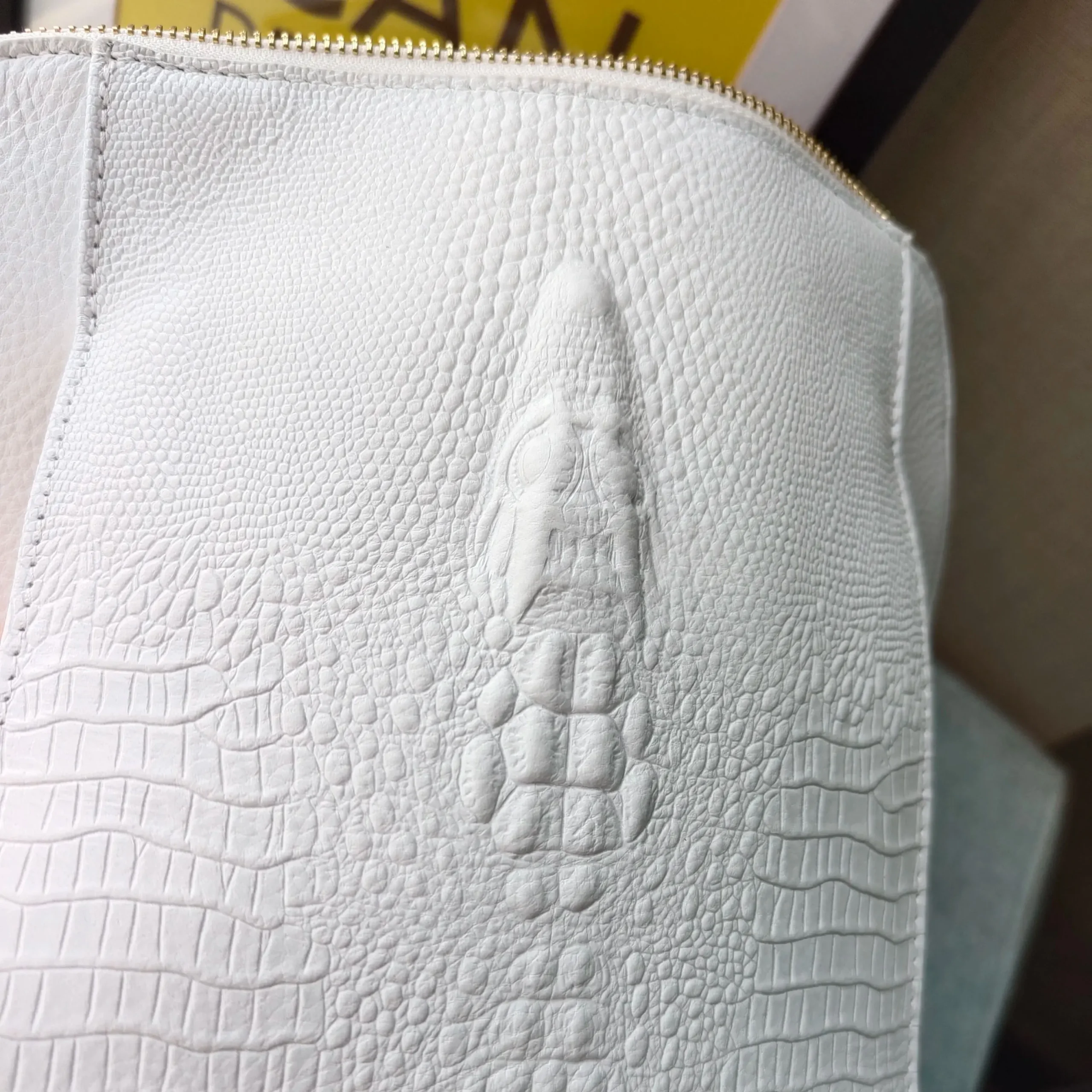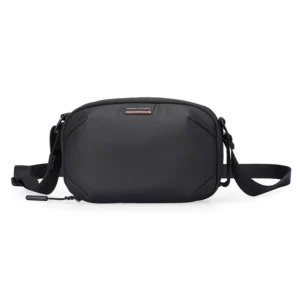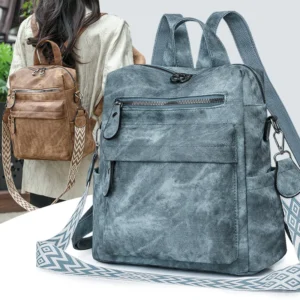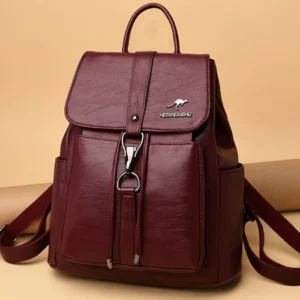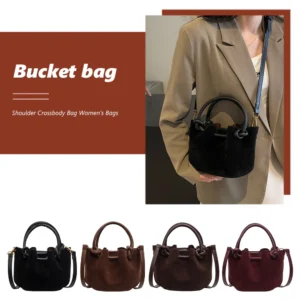Understanding Lightweight Leather: What Makes Some Leather Bags Lighter Than Others
The term “lightweight” in leather bags typically refers to products weighing under 2-2.5 pounds (0.9-1.1 kg). This might not sound like much on paper, but anyone who has carried a heavy bag all day knows that every ounce matters. The weight difference becomes especially noticeable after hours of shopping, commuting, or traveling.
Leather weight is measured in ounces per square foot or grams per square meter, with lighter leathers generally falling in the 2-4 oz per square foot range. Traditionally, leather bags were notoriously heavy because craftspeople used thick hides and substantial hardware to ensure durability. This conventional approach prioritized longevity over comfort, leaving many people suffering from unnecessary shoulder and back strain.
Modern manufacturing has revolutionized this balance. Today’s techniques allow for creating durable leather goods that don’t sacrifice strength while significantly reducing weight. This development addresses an important health consideration – medical experts consistently warn that regularly carrying heavy bags can lead to muscle imbalances, poor posture, and even chronic pain.
For perspective, traditional leather totes often weigh 3-4 pounds (1.4-1.8 kg) empty, while modern lightweight options start around 1-1.5 pounds (0.45-0.7 kg). This difference becomes even more significant when you consider that most people carry 5-10 pounds (2.3-4.5 kg) of items daily. Studies suggest that bags shouldn’t exceed 10-15% of your body weight to prevent strain, making the starting weight of your empty bag crucial.
Understanding these weight considerations becomes essential when shopping for compact leather backpacks for women, as the right balance of materials and construction can dramatically affect daily comfort. Beyond just comfort, there are significant health benefits of lightweight bags that include reduced risk of muscle strain, better posture maintenance, and decreased likelihood of developing chronic pain conditions.
The Science Behind Lightweight Leather Types
Different leather types naturally vary in weight while offering unique combinations of durability and flexibility. Understanding these variations helps you choose a bag that meets your specific needs:
Calfskin: Naturally supple with lower density, calfskin provides an excellent strength-to-weight ratio. Typically weighing 3-4 oz/sq ft (90-120 g/sq m), it offers remarkable durability despite its lightness.
Goatskin: Features an exceptionally strong fiber structure despite its thinness. At 2-3 oz/sq ft (60-90 g/sq m), goatskin is among the lightest leather options that still maintain excellent durability.
Sheepskin/Lambskin: Extremely lightweight at 1.5-2.5 oz/sq ft (45-75 g/sq m), these leathers offer unmatched softness but require careful treatment as they’re more delicate than other options.
Nappa leather: This butter-soft leather undergoes special processing to achieve its characteristic flexibility and reduced weight, typically 2.5-3.5 oz/sq ft (75-105 g/sq m).
Tumbled full-grain leather: The tumbling process softens full-grain leather while maintaining its natural strength. This creates a more pliable, often lighter product (3-5 oz/sq ft or 90-150 g/sq m) without sacrificing the durability benefits of full-grain construction.
Thickness plays a crucial role in weight—measured in millimeters, even a 0.5mm difference can significantly impact the final weight of a bag. Premium tanneries like Horween (USA), Badalassi Carlo (Italy), and La Perla Azzurra (Italy) have developed specialized lightweight leather options that maintain premium quality standards.
Selecting the right leather type for your needs involves balancing these weight considerations with your specific usage patterns. For those seeking quality without excessive weight, exploring collections of full-grain leather backpacks can reveal options that masterfully balance durability with comfortable carrying weight.
Tanning and Processing: How Modern Techniques Create Lighter Leathers
Vegetable vs. Chrome Tanning
The tanning method significantly impacts leather weight. Vegetable-tanned leather, using natural plant extracts, typically produces a firmer, slightly heavier product with exceptional aging characteristics. Chrome tanning, utilizing chromium sulfates, creates more flexible and lightweight leather. Many premium lightweight bags use a combination approach, capturing benefits of both methods while minimizing weight.
Drying Techniques
How leather dries after tanning dramatically affects its weight and feel. Air-dried leathers retain more natural characteristics but often have less consistent weight. Vacuum-drying technology removes moisture more efficiently, creating predictably lighter-weight leather without compromising strength.
Splitting and Skiving
Modern leather processing employs precision techniques to reduce weight without sacrificing quality. Splitting divides thick hides horizontally to create thinner, lighter leather pieces. Skiving thins specific areas, particularly at edges and seams, removing unnecessary weight while maintaining structural integrity at stress points.
Finishing Touches
The finishing process can significantly influence a leather bag’s final weight. Drum-dyeing infuses color throughout the leather without adding weight, while surface painting or heavy finishes can add unnecessary ounces. Premium lightweight bags typically use minimal finishing techniques that protect the leather without building up heavy layers.
Construction Elements That Determine Bag Weight
The materials used in a leather bag tell only part of the weight story. Construction details significantly impact the final weight and functionality of the finished product.
Hardware Impact
Metal components contribute substantially to a bag’s overall weight:
- Zippers: Heavy brass or steel zippers can add several ounces, while lightweight aluminum or specialized polymer alternatives cut weight without compromising function.
- Buckles and clasps: Traditional solid brass buckles might look luxurious but add significant weight. Modern lightweight alternatives made from hollow metals or advanced alloys reduce weight by 40-60%.
- Straps: Chain straps can add 4-8 ounces (113-226 grams) compared to leather alternatives. Some designers use chain only for decorative portions while using leather for weight-bearing sections.
Lining Choices
Interior materials significantly affect weight:
* Heavy cotton canvas adds durability but can add 3-5 ounces (85-140 grams)
* Lightweight microfiber reduces weight by up to 70% compared to traditional linings
* Modern technical fabrics offer water resistance without the weight penalty of older waterproofing methods
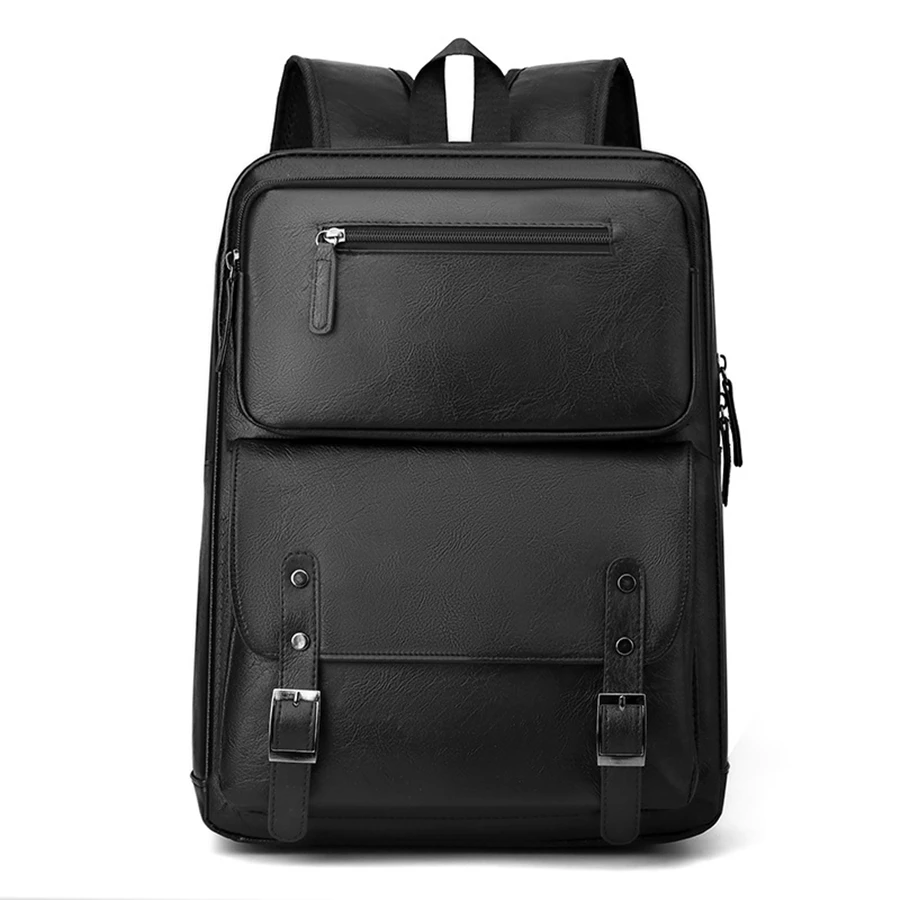
Reinforcement Techniques
Structural elements create interesting weight tradeoffs:
* Structured bags maintain their shape but require additional materials that add weight
* Unstructured designs reduce weight but may not protect contents as effectively
* Edge treatments like rolling (folding leather over itself) add durability but also weight
* Modern edge painting provides protection with minimal weight addition
The integration of these elements requires thoughtful design decisions. Understanding specific hardware and construction features in women’s backpacks helps in evaluating which weight-saving measures actually enhance functionality rather than compromise it.
Design Features: Finding Balance Between Organization and Lightness
Creating a lightweight leather bag that remains practical requires thoughtful design that maximizes functionality while minimizing unnecessary elements. The most successful lightweight designs focus on:
- Minimalist core structures that eliminate non-essential compartments and dividers
- Strategic pocket placement that maintains organization without adding layers of material
- Multi-functional elements where single components serve multiple purposes
- Lightweight organizational systems using fabric dividers instead of leather
- Smart strap engineering with ergonomic shaping that distributes weight effectively
Well-designed lightweight bags incorporate clever features like:
- Slip pockets instead of zippered compartments where security isn’t critical
- Flexible dividers that add minimal weight but enhance organization
- Hidden storage areas integrated into existing structural elements
- Removable organizers that allow users to customize weight based on daily needs
- Strategically reinforced areas only where stress points demand additional material
What makes these design approaches impressive is how they maintain functionality per ounce. For example, a thoughtfully designed 1.5-pound (0.7 kg) bag might offer 90% of the organizational capability of a 2.5-pound (1.1 kg) alternative through smarter space utilization.
For those seeking practical daily options, exploring small leather backpacks with smart organization can reveal how these design principles work in real-world products. The best designs don’t just remove features to cut weight—they reimagine how functionality can be achieved more efficiently.
How to Evaluate a Lightweight Leather Bag: Your Essential Checklist
When shopping for lightweight leather bags, use this practical checklist to ensure you’re getting quality without unnecessary weight:
Weight specifications: Look for exact weight measurements in product descriptions (under 2-2.5 pounds or 0.9-1.1 kg is generally considered lightweight for leather). Be skeptical of listings that avoid mentioning weight.
Material transparency: Quality manufacturers specify exactly what type of leather they use and what the lining is made from. Vague descriptions like “genuine leather” without specifics may hide heavier, lower-quality materials.
Hardware assessment: Examine photos carefully for hardware size and construction. Oversized or numerous metal elements add significant weight. Look for streamlined buckles, zippers, and clasps that maintain functionality without bulk.
Construction evaluation: Check for:
* Clean, precise stitching with appropriate thread weight
* Thoughtful edge finishing that doesn’t add unnecessary bulk
* Minimal seams where possible
* Strategic reinforcement only where neededFunctionality testing: If possible, test the bag with your typical daily items. A truly well-designed lightweight bag distributes weight evenly and remains comfortable when loaded.
Comfort factors: Beyond raw weight, examine:
* Strap width (wider straps distribute weight more comfortably)
* Padding placement
* Balance point when carried
* Flexibility that allows the bag to conform to your bodyDurability indicators: Ensure lightness doesn’t compromise longevity by checking:
* Reinforcement at stress points
* Quality of hardware attachment points
* Appropriate leather thickness for high-wear areas
Red flags include unusually light weight for the size without explanation of special materials or techniques, unfinished edges, and inconsistent material thickness. Remember that a quality lightweight bag should feel substantial enough to protect contents while eliminating unnecessary weight.
For more comprehensive guidance on evaluating smaller leather bags, the ultimate guide to small leather backpacks provides additional insights into quality indicators specific to compact designs.
Top Lightweight Leather Totes for Professional Settings
Professional environments demand bags that project competence while remaining practical for daily use. These lightweight leather totes balance professional aesthetics with comfort:
| Feature | Classic Executive Tote | Minimalist Workday Tote | Expandable Professional Carry |
|---|---|---|---|
| Weight | 1.7 lbs (0.77 kg) | 1.4 lbs (0.64 kg) | 1.9 lbs (0.86 kg) |
| Dimensions | 15” × 12” × 4” | 14” × 11” × 3” | 16” × 13” × 3-5” |
| Leather Type | Tumbled full-grain calfskin | Lightweight nappa leather | Semi-aniline goatskin |
| Laptop Capacity | Up to 14” | Up to 13” | Up to 15” |
| Organization | 2 main compartments, 3 interior pockets, 1 exterior pocket | Single compartment, 4 interior slip pockets, key leash | Expandable main compartment, removable organizer, exterior quick-access pocket |
| Notable Feature | Convertible straps for shoulder or hand carry | Ultra-minimal design with concealed magnetic closure | Expansion system increases capacity by 40% when needed |
What sets these professional totes apart is how they maintain businesslike aesthetics while significantly reducing weight compared to traditional leather work bags that often weigh 3+ pounds empty. User reviews consistently highlight the comfort difference during commutes, with many noting reduced shoulder and neck tension after switching to lightweight options.
For those seeking professional options beyond totes, exploring women’s leather work backpack options provides alternatives that distribute weight even more effectively while maintaining a professional appearance.
Lightweight Leather Crossbody and Shoulder Bags for Everyday Ease
For daily errands and casual outings, lightweight crossbody and shoulder bags offer hands-free convenience without weighing you down:
| Feature | Compact Crossbody | Expandable Day Bag | Multi-Wear Convertible |
|---|---|---|---|
| Weight | 0.9 lbs (0.41 kg) | 1.3 lbs (0.59 kg) | 1.2 lbs (0.54 kg) |
| Dimensions | 8” × 6” × 2” | 10” × 8” × 3” | 9” × 7” × 2.5” |
| Leather Type | Soft goatskin | Lightweight pebbled calfskin | Tumbled full-grain leather |
| Strap Feature | Adjustable, padded section for shoulder comfort | Wider strap distribution with ergonomic curve | Convertible between crossbody, shoulder, and wristlet |
| Organization | Main compartment, front slip pocket, back zippered pocket | Two separate compartments, expandable side gussets, hidden phone pocket | Modular interior with removable divider, exterior card slot |
| Notable Feature | Weighs less than most synthetic bags of similar size | Expands from 3” to 5” depth as needed | Innovative strap system changes configuration without hardware |
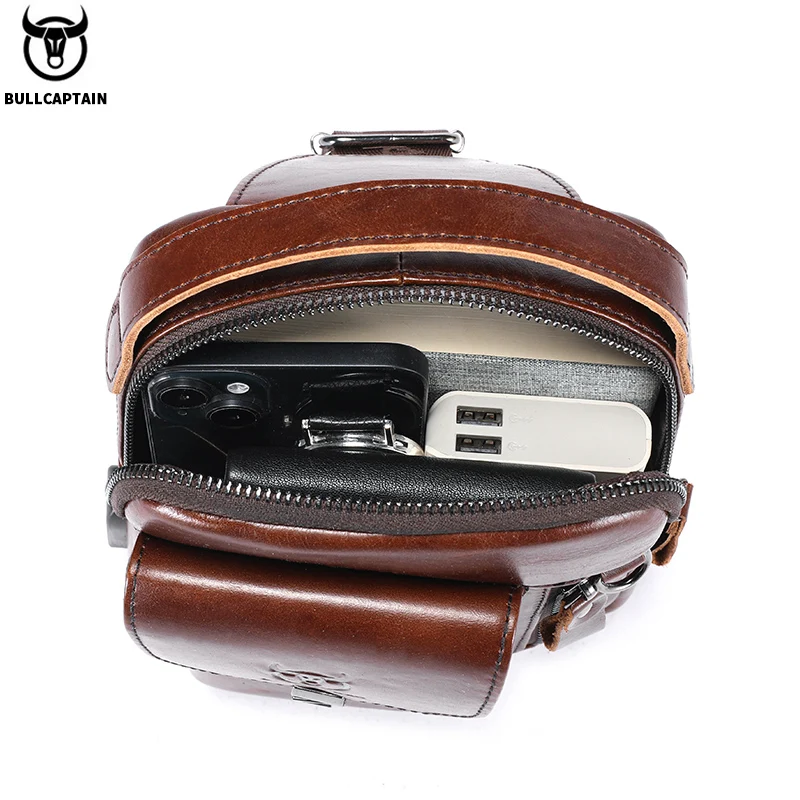
These crossbody options demonstrate impressive capacity-to-weight ratios, with the Compact Crossbody capable of carrying essentials for a full day while weighing less than a pound. User feedback consistently mentions the comfort difference during extended wear, with many noting they “forget they’re wearing it” even after hours of use.
The weight distribution in these designs shows particular attention to biomechanics, with strategic strap placement that prevents the digging and pressure points common in heavier bags. For those interested in crossbody options with additional security features, crossbody leather sling backpack designs offer alternative carrying positions that maintain lightweight benefits.
Innovative Lightweight Leather Backpacks Balancing Style and Comfort
Backpacks distribute weight more effectively than single-shoulder bags, making lightweight leather versions particularly comfortable for commuting or travel:
| Feature | Urban Commuter Pack | Minimalist Day Pack | Convertible Business Pack |
|---|---|---|---|
| Weight | 1.8 lbs (0.82 kg) | 1.5 lbs (0.68 kg) | 2.1 lbs (0.95 kg) |
| Dimensions | 13” × 11” × 4” | 12” × 9” × 3” | 15” × 12” × 4” |
| Leather Type | Tumbled full-grain leather | Lightweight calfskin | Semi-aniline leather with strategic reinforcement |
| Ergonomic Features | Contoured shoulder straps, padded back panel | Ultra-light mesh-backed straps, minimal but effective padding | Adjustable load-lifter straps, convertible carrying options |
| Organization | Laptop compartment, main chamber, front organizer pocket | Single main compartment with clever folding divider system | Business organizer, laptop protection, quick-access pockets |
These backpack designs weigh 30-40% less than traditional leather backpacks while maintaining professional aesthetics. Users consistently report improved comfort during commutes, with several mentioning they’ve switched from synthetic bags specifically because these lightweight leather options offer similar comfort with more sophisticated styling.
Brown Leather Sling Backpack, Crossbody Leather Sling Backpack, Men's Leather Sling Backpack
Price range: $191.96 through $193.72 Select options This product has multiple variants. The options may be chosen on the product pageDesigner Mini Backpack, Mini Leather Backpack, Small Leather Sling Backpack, Women's Leather Backpack
Price range: $95.76 through $98.80 Select options This product has multiple variants. The options may be chosen on the product pageBlack Leather Sling Backpack, Crossbody Leather Sling Backpack, Small Leather Sling Backpack
Price range: $103.88 through $104.08 Select options This product has multiple variants. The options may be chosen on the product pageBlack Leather Backpack, Small Leather Backpack, Women's Leather Backpack
Price range: $112.96 through $116.12 Select options This product has multiple variants. The options may be chosen on the product pageLuxury Leather Backpack, Small Leather Backpack, Women's Leather Backpack
Price range: $137.48 through $138.28 Select options This product has multiple variants. The options may be chosen on the product pageSmall Leather Sling Backpack, Women's Leather Sling Backpack
Price range: $70.76 through $80.20 Select options This product has multiple variants. The options may be chosen on the product page
For those seeking maximum versatility in a lightweight package, compact backpacks that are both lightweight and versatile offer designs that transition seamlessly between casual and professional settings without adding unnecessary weight.
Care and Maintenance: Preserving Your Lightweight Leather Bag’s Beauty
Lightweight leather requires slightly different care than traditional heavy leather to maintain its unique properties:
Cleaning Approach by Leather Type:
* For lightweight calfskin: Use a damp, soft cloth with minimal water. Avoid soaking, as thinner leathers absorb moisture more readily.
* For goatskin and other lightweight options: Gentle leather cleaner applied sparingly with a microfiber cloth works best.
Conditioning Considerations:
1. Choose lightweight conditioners specifically formulated for fine leathers (beeswax-heavy products can add weight and stiffen lightweight leathers)
2. Apply sparingly—lightweight leathers need less product than thicker varieties
3. Use a soft cloth and work in small circular motions
4. Allow absorption time before buffing away any excess
Storage Recommendations:
* Store unstructured lightweight bags with acid-free tissue paper to maintain shape without adding permanent structure
* Keep in dust bags but avoid plastic covers that can trap moisture
* Store upright rather than hanging to prevent stress on handles and straps
With proper care, lightweight leather develops a beautiful patina without losing its suppleness or becoming stiff. The key difference in maintenance is the “less is more” approach—using smaller amounts of product and gentler techniques than you might with thicker leather goods.
For comprehensive maintenance information applicable to all leather bags, the guide on how to maintain leather backpacks provides additional techniques that help extend the life of your investment.
Why Choose a Summit Carry Lightweight Leather Bag?
Summit Carry has developed a distinctive approach to creating lightweight leather goods that stands apart from conventional methods. Rather than simply using thinner materials (which can compromise durability), the brand employs a comprehensive weight-reduction strategy throughout the design and production process.
This approach begins with careful leather selection—sourcing premium full-grain hides that offer natural strength even at lower weights. The tanning and finishing processes preserve the leather’s natural characteristics while enhancing flexibility and reducing unnecessary density.
What truly distinguishes Summit Carry’s lightweight designs is the thoughtful construction philosophy. Each bag undergoes a meticulous engineering process where every component is evaluated for its weight contribution and functionality. Hardware is selected not just for aesthetics but for its optimized strength-to-weight ratio.
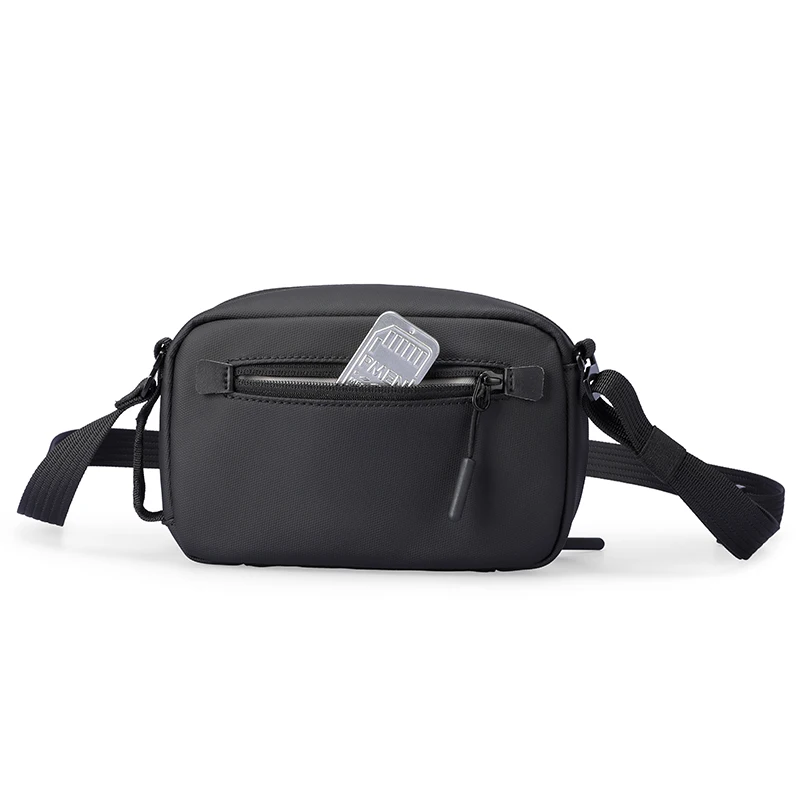
The brand’s commitment to functional comfort shines through in ergonomic features that enhance weight distribution—wider straps placed at biomechanically advantageous positions, strategic padding only where needed, and balanced proportions that keep the bag stable when carried.
For those seeking an introduction to Summit Carry’s approach to lightweight design, the lightweight sling backpack collection showcases how these principles translate to compact, everyday carry options.
Frequently Asked Questions About Lightweight Leather Bags
Are lightweight leather bags less durable than heavier ones?
Not necessarily. Durability depends more on leather quality and construction techniques than weight alone. Premium lightweight leather bags use high-grade materials strategically, reinforcing stress points while reducing bulk in non-critical areas. With proper care, a well-made lightweight leather bag can last for many years.
How much should a lightweight leather bag weigh?
For a medium-sized bag, anything under 2-2.5 pounds (0.9-1.1 kg) when empty would be considered lightweight for leather. Small crossbody bags might weigh less than 1 pound (0.45 kg), while larger totes or backpacks typically range from 1.5-2.5 pounds (0.7-1.1 kg).
Can genuine leather truly be lightweight?
Yes, absolutely. The weight of leather varies significantly based on animal source, tanning method, and processing techniques. Certain leathers like carefully processed goatskin and calfskin are naturally lightweight while maintaining excellent durability.
Do lightweight leather bags require special care?
They benefit from slightly modified care routines. Use lighter applications of conditioner, avoid soaking them during cleaning, and be more gentle when handling them. However, the basic principles of leather care still apply.
How long do lightweight leather bags typically last?
With proper care, premium lightweight leather bags can last 5-10 years or more of regular use. The lifespan depends primarily on construction quality, leather type, usage patterns, and maintenance—not just weight.
Can lightweight leather bags hold heavy items without straining?
Well-designed lightweight bags include reinforcement at stress points specifically to handle weight. However, consistently overloading any bag beyond its intended capacity will eventually cause wear. Look for bags with strategic reinforcement at handles, strap attachments, and base.
